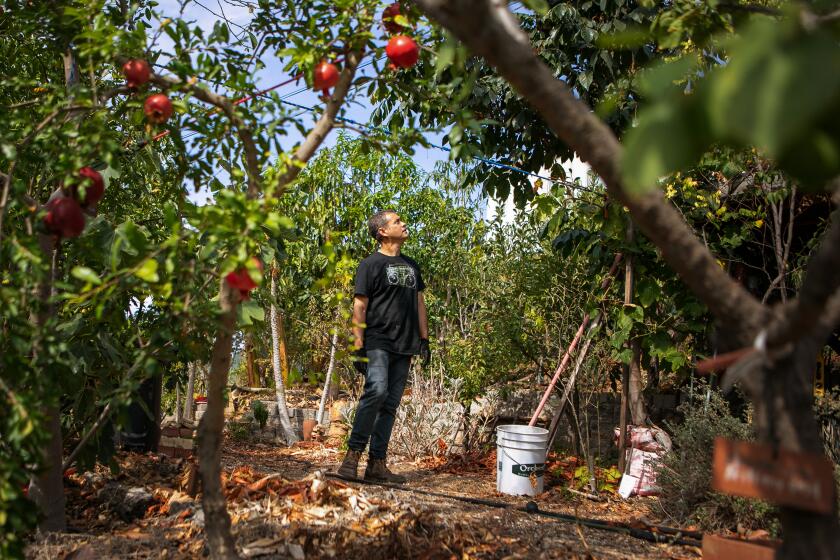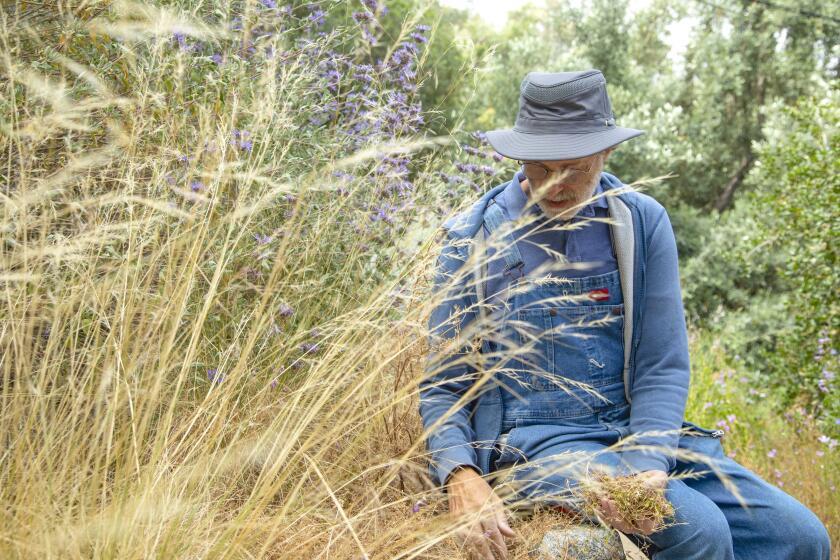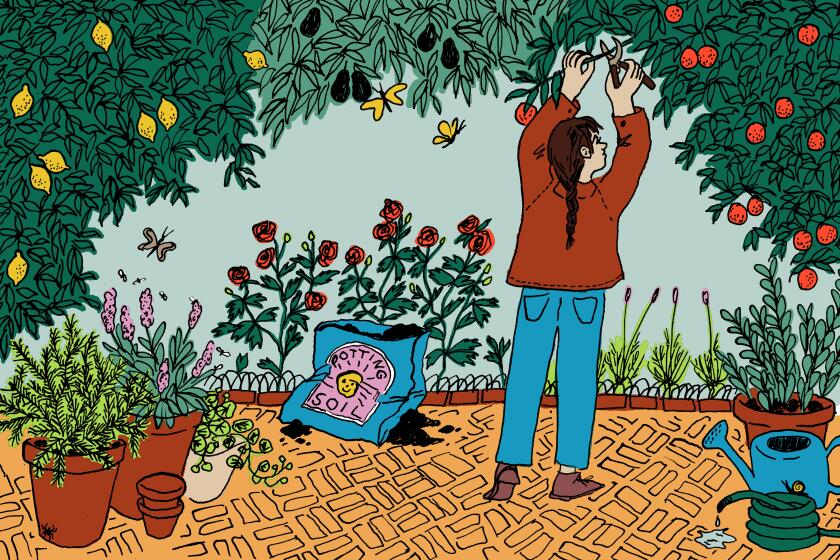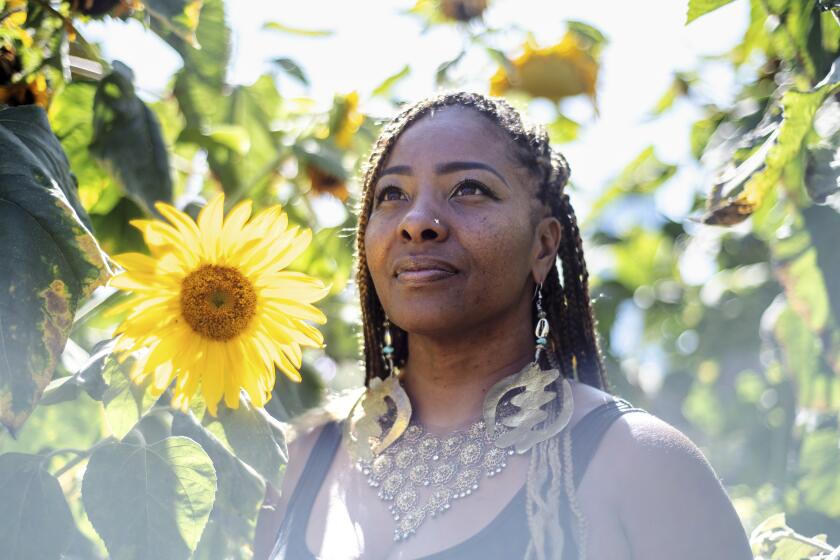How gardening may extend your life and make it better
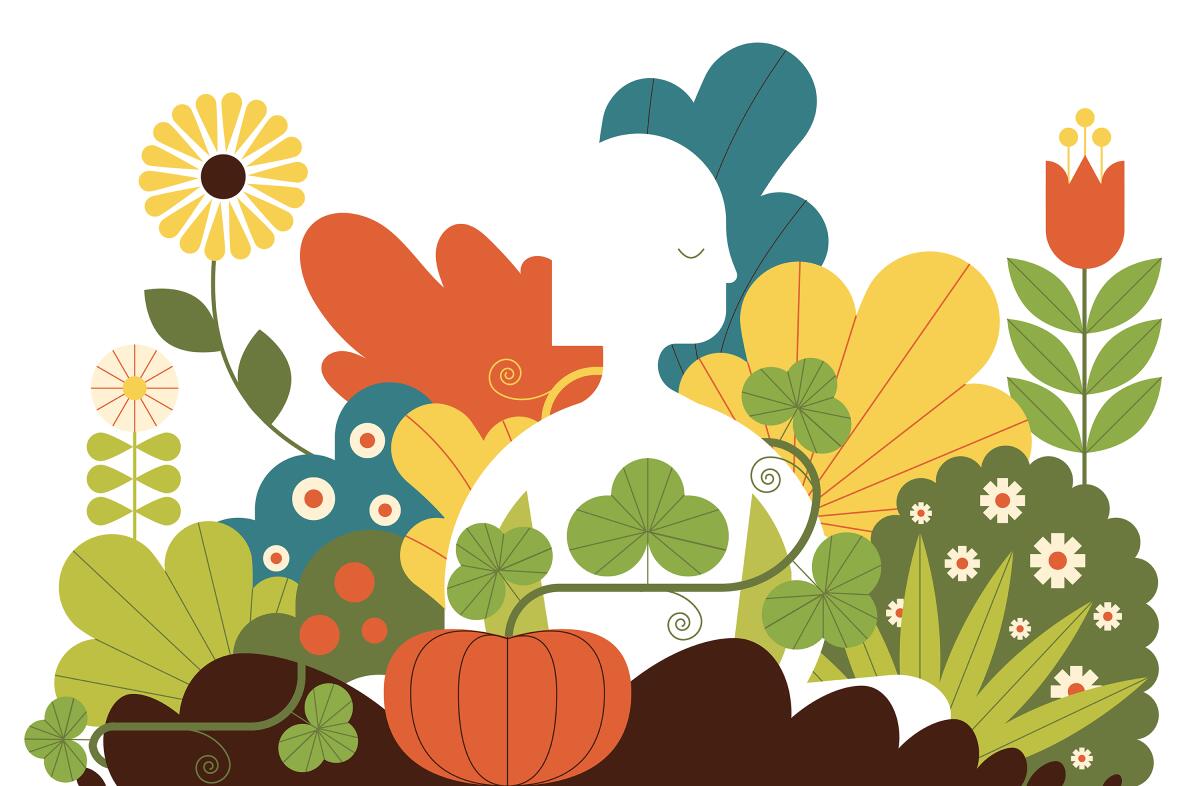
True confessions from a plant reporter and devotee of more than 40 years: My first foray into gardening was a pathetic disaster.
I was barely 20, struggling with depression and getting through college. My husband and I rented a lovely house in Riverside with a mature and well-tended landscape. There was a lawn, a patio shaded by a sprawling rose bush, a few fruit trees and a bare spot behind a fence where one could plant a garden.
My husband had little interest in growing vegetables, but I had earth mother delusions and a desperate need for distraction from my grim academic realities. Corn and beans would be nice, I grandly decided, plus a few cantaloupe plants, tomatoes and sunflowers. Never mind that I had never grown any of these things. I bought some seeds and seedlings. I dug some holes. I planted my garden and then I walked away.
I didn’t know a thing about amending the soil or making sure my plants got at least six to eight hours of sunlight every day. Mulch was something on a forest floor, right? And watering was a hit-or-miss thing — mostly miss, since the fence between the house and what my landlord called the “unsightly” area behind the fence made it easy for me to forget I was “gardening” as I tried to save myself from academic ruin.
Instead of a lawn, Jose Ramirez planted 250 trees, including avocados, limes, apples, mangoes and even coffee beans in his Boyle Heights yard.
Thus, the cantaloupe and beans made a valiant effort to sprout and then withered away. My sunflowers struggled to a paltry height and produced some exhausted blooms. The corn followed the sunflowers, scrawny stalks that got about three feet tall before they tasseled and produced a couple of very slender ears.
The tomatoes fared better — sort of. They were planted near the patio, where they at least got sprinkler water. A friend casually suggested that I add some fertilizer. I found a bag of lawn food in the garage — essentially powdered nitrogen — and grew the most enormous plants I’d ever seen, except they were all leaves with absolutely no blossoms or tomatoes.
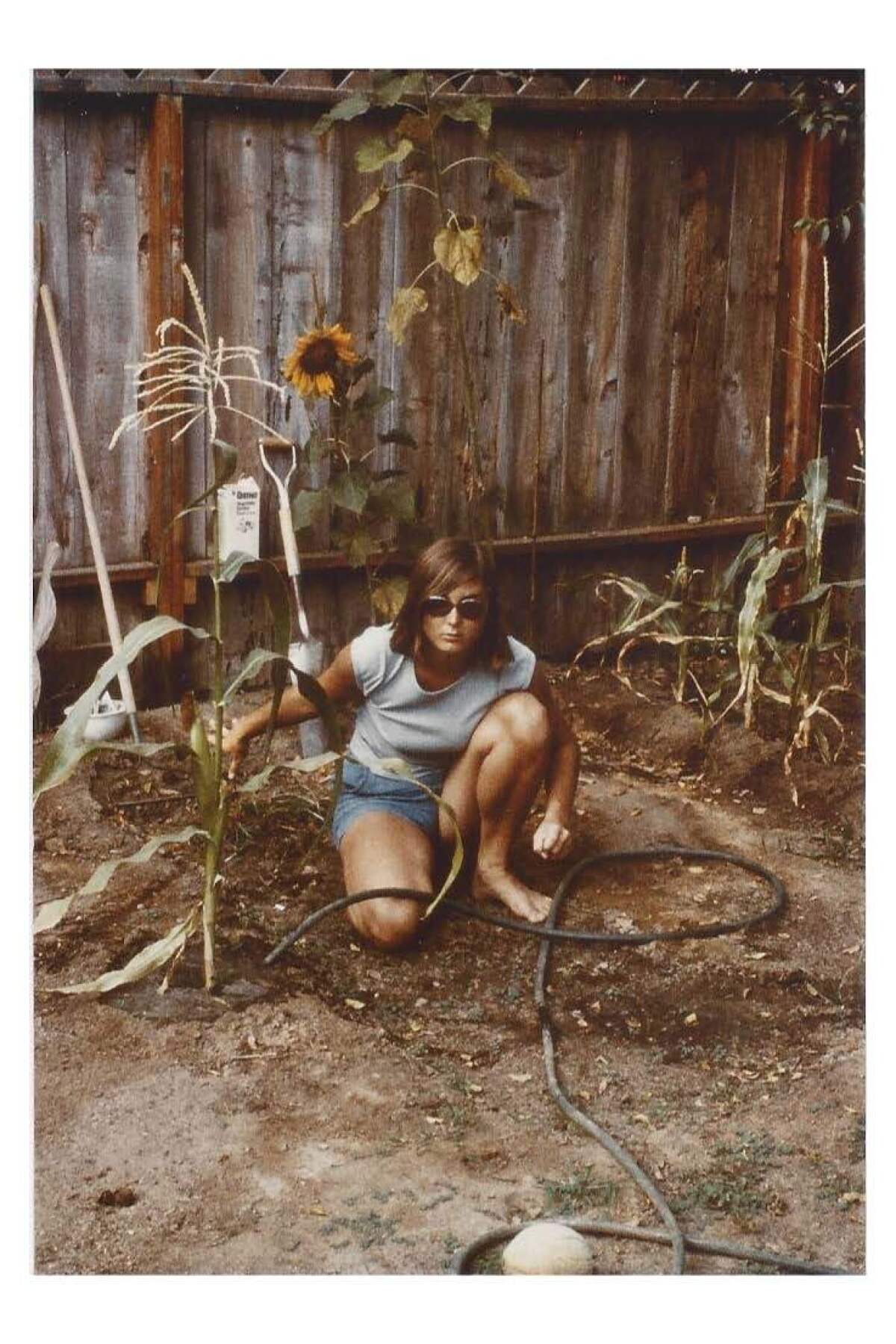
As you can see from my clenched fist and scowl in the above photo, that first garden was more guilty frustration than happy place. But even then, the simple act of planting and tending, no matter how haphazardly, gave me a sense of achievement sorely lacking in the rest of my life. Maybe that’s why I kept coming back for more, despite that rocky start and the many mistakes to come.
That and the inspiration from a long line of casual family gardeners.
My father grew huge tomato plants with fruit every summer and tasked me and my siblings with hunting down the hornworms that threatened to devour them. My mother routinely pierced avocado seeds with toothpicks and sprouted new trees in her kitchen window. My father patiently transplanted those little avocado trees into the yard and then grafted desirable scions on the ones that survived.
My Greek immigrant grandmother tended a patch of the most fragrant culinary herb I’ve ever encountered, which she sprinkled liberally on salads, meat, pasta ... really, just about everything but waffles. Our family called it “Greek oregano,” but when I tried to grow my own years later, I discovered that it was actually a type of marjoram. Her brother, my great-uncle, tended a huge arbor of grapes outside their Bakersfield home. My sisters and I would loll on a cot under its shade, immobilized by the sticky heat and mesmerizing terror as wasps floated among the leaves like drunken marionettes, sipping on overripe fruit.
As the drought continues, Californians are tearing out their lawns. Here’s a DIY guide to killing grass to prep for a drought-tolerant landscape.
These memories are an indelible part of my childhood, fleeting but so tangible I can almost taste them. Every time I wanted to give up on gardening, they nurtured me and gave me hope. They were an example of what could be if I’d just keep trying.
And I did, for years and years, starting some kind of garden everywhere I landed. Some were legendary (the ones my parents helped me build); others were ridiculous, especially after I became a mom — plants hurriedly thrown in the ground with a whispered “Good luck,” and left to fight alone against an onslaught of weeds.
Yet despite my ignorance and neglect, my gardens were always there for me when I needed to breathe or cry or take out my rage on an army of weeds. And, as for many others, gardening saved my sanity during the COVID-19 pandemic. Digging in the dirt grounded me and made me calmer. My garden chores gave me purpose during those dark days and connection with neighbors who would stop to admire — from a distance — even my most pathetic attempts.
On my worst days, my garden was a reason to get out of bed in the morning, and the one thing that made me smile.
Gardening has a beginning, middle and end (except for weeding, of course). There is discovery and growth — a pumpkin that doubled in size overnight, a rose in perfect bloom or the sudden gush of fragrance as you accidentally drag a hose through a patch of hummingbird sage.
Lest you think this is all the sentimental musings of a woman gone plant mad, know that my experiences have been reinforced by evidence-based research. Studies from South Korea, Finland, Australia and the U.S. point to the power of gardening to extend and enrich our lives.
Over the last 20 years, dozens of studies have shown that working in a garden, walking in a garden, even looking at a garden from afar have tangible, measurable benefits.
“As a scientist, I’m skeptical of really extravagant claims,” said Don Rakow, professor of horticulture at Cornell University’s School of Integrative Plant Science in Ithaca, N.Y. “But the evidence is so strong at this point, after so many studies, that we have confirmed that time in nature, including gardening, is absolutely beneficial to us in a number of ways.”
In 2020, Rakow participated in a study that looked at how being in contact with soil and plants affected the cortisol hormones that help people manage stress. “We found, at least for the college-age audience, that spending 10 to 20 minutes outdoors in nature, either in a woodland or garden, two or three times a week has real and measurable physiological benefits,” Rakow said. “It’s very likely that we can extrapolate — if it’s beneficial to that age group, it would be equally beneficial to other age groups.”
Native plant gardens can look dead over the summer, but there are things you can do to tend to the dried-out vegetation.
You don’t have to be an expert gardener to reap the benefits. In fact, several studies indicate benefits from just being around soil laced with bacteria that doesn’t cause disease: Mycobacterium vaccae or M. vaccae for short. This species of benign bacteria exists in soil all over the world, but it was first discovered on the shore of Lake Kyoga in Uganda in the 1970s by immunologist John Stanford after researchers noticed that leprosy patients who lived around the lake responded better to treatments than those receiving the same treatment in other areas.
Christopher Lowry, a professor at University of Colorado Boulder, has spent more than 20 years studying and marveling at microorganisms in the natural world that help humans fight disease, known as “old friends.” Their absence in rich urban countries like the U.S. has made children more prone to allergies and inflammatory diseases.
In 2007, Lowry was the lead author of a study published in the scientific journal Neuroscience showing that mice exposed to M. vaccae had increased serotonin levels in their brains, fueling headlines like: “Is Dirt the New Anti-Depressant?” (A promising notion, but too early to say, Lowry noted.) In a 2016 study published in the Proceedings of the National Academy of Sciences, Lowry and a team of 28 researchers found that mice injected with M. vaccae had less anxiety and inflammation — the kind that causes stress and stress-related diseases like colitis — even when they were housed with aggressive bully mice.
Now he’s part of a group studying whether 31 military veterans who take a probiotic laced with a bacteria similar to M. vaccae have less inflammation. Stress elevates inflammation in the body, and increased inflammation causes all kinds of physical problems, especially in joints and organs.
The research is ongoing, and larger studies are needed, Lowry said, but the evidence to date suggests the anti-inflammatory bacterium could make people more resilient to stress. How useful, he said, if M. vaccae could be used to help people feel calmer — and consequently think more clearly — in stressful situations, such as going into combat.
We found the questions people ask most frequently about gardening and outdoor plants and went to local experts in Southern California to get some answers.
Another intriguing idea, Lowry said, is that we may not need to take a pill or get a shot to reap the benefits of this bacteria — the goodness could be waiting for us in our gardens.
“In 2007, I said in an interview that the results make us wonder if we should all spend more time playing in the dirt,” Lowry said. “I am still wondering today, but I think I might modify that statement now to say, ‘The evidence is accumulating that we should all spend more time playing in the dirt.’”
Two recent studies really reinforce this for Lowry.
- In Finland, researchers brought soil from a forest floor into the play area of a daycare center, along with lawn turf and boxes where 75 children ages 3 to 5 planted and tended crops. According to the 2020 study, after 28 days, skin, stool and blood samples indicated that children who played in forest-enhanced play yards had stronger immune system activity than children who played in traditional asphalt and gravel play yards.
- And in South Korea, 29 adults ages 20 to 59 were asked to use their hands to mix sterilized soil with soil that did not contain microorganisms, and then mix sterilized soil with soil containing M. vaccae. Researchers recorded participants’ brain and heart activity and took blood samples. After just five minutes of activity, according to the 2022 study published in the Journal of the American Society for Horticultural Science, the M. vaccae mixers had significantly lower heart rates as well as changes in brain activity and their blood. How does this work? Is it through skin contact or breathing in the bacteria? And are those changes in brain activity and blood good or bad? More research is needed to answer those questions, Lowry said. “Really, it almost defies belief, it’s just so extraordinary, that simply having mycobacterium in the soil alters activities in the brain and the chemicals circulating in the blood,” he said. “And everything we know about M. vaccae so far would indicate that the exposure is good.”
Other studies have looked beyond the effects of “friendly” bacteria and found that:
- Gardening has ties to longevity, according to a 2018 article published in the journal Clinical Medicine. Gardening not only provides a constant supply of fresh vegetables but it can also reduce stress and increase vitamin D exposure from the sun. Gardening also offers a sense of accomplishment and purpose as well as social interaction, another important key to longevity.
- Gardening is better at reducing stress and improving your mood than reading. In a 2011 study published in the Journal of Health Psychology, researchers in the Netherlands had 30 gardeners take tests on a computer that falsely gave them low scores and then assigned them to 30 minutes of working in a garden or 30 minutes of indoor reading. The researchers repeatedly tested participants’ saliva for stress hormones and asked them to report their mood over time. The gardeners had lower levels of stress hormones and higher levels of positive moods. In a surprising outcome, according to the study, the readers reported that their negative mood worsened.
- Just looking at gardens may hasten healing, according to a series of studies led by Roger Ulrich. In 1984, researchers looked at patients in a suburban Pennsylvania hospital who had their gall bladders removed between 1972 and 1981 and discovered that 23 surgical patients with a window view of a natural setting had shorter postoperative hospital stays, used fewer pain medications and received fewer negative evaluations from their nurses than 23 other cholecystectomy patients whose only window view was of a brick wall. Douglas Kent, an Orange-based landscape architect and author who teaches at Cal Poly Pomona, said that this and similar studies about restorative landscapes in urban settings changed the way he approaches landscaping. “For the first time, I started designing from the inside of the house, asking: ‘What was their view when they were brushing their teeth or standing in their kitchen?’”
- Daily gardening was associated with a reduced risk of developing dementia, according to a 2006 study of the elderly in Australia. Researchers followed 2,805 men and women 60 or older for 16 years to try to identify risk factors for dementia in seniors. Over that time, the researchers found a 36% lower risk for dementia among those who gardened daily.
Not surprisingly, Lowry and Rakow are both avid, longtime gardeners, but like most scientists, they still talk carefully, almost protectively about this research, lest anyone draw conclusions too early in the game.
Plants sustained Genea Richardson in prison and led to a job after she got out. She now trains formerly incarcerated people to work in landscaping.
It just feels sensible that humans need connection with the natural world to thrive, and what can be more basic and natural than digging in soil? But can it really be that simple? Rakow and Lowry are heartened by the mounting evidence, but as scientists, they’re not ready to make such a sweeping statement.
That’s OK. I’ve got all the data I need. If my spirits are flagging or my energy is dragging, my findings say it’s time to go outside and get some dirt under my nails.
More to Read
Sign up for The Wild
We’ll help you find the best places to hike, bike and run, as well as the perfect silent spots for meditation and yoga.
You may occasionally receive promotional content from the Los Angeles Times.
